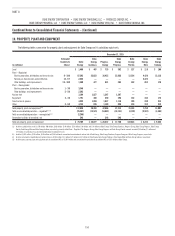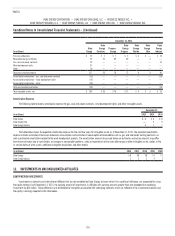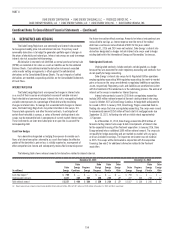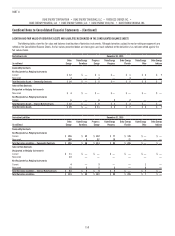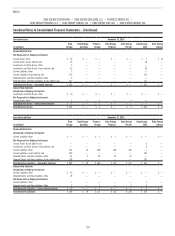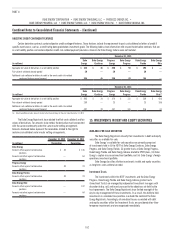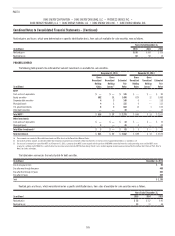Duke Energy 2015 Annual Report Download - page 176
Download and view the complete annual report
Please find page 176 of the 2015 Duke Energy annual report below. You can navigate through the pages in the report by either clicking on the pages listed below, or by using the keyword search tool below to find specific information within the annual report.
156
PART II
DUKE ENERGY CORPORATION • DUKE ENERGY CAROLINAS, LLC • PROGRESS ENERGY, INC. •
DUKE ENERGY PROGRESS, LLC • DUKE ENERGY FLORIDA, LLC • DUKE ENERGY OHIO, INC. • DUKE ENERGY INDIANA, INC.
Combined Notes To Consolidated Financial Statements – (Continued)
14. DERIVATIVES AND HEDGING
The Duke Energy Registrants use commodity and interest rate contracts
to manage commodity price risk and interest rate risk. The primary use of
commodity derivatives is to hedge the generation portfolio against changes in
the prices of electricity and natural gas. Interest rate swaps are used to manage
interest rate risk associated with borrowings.
All derivative instruments not identified as normal purchase/normal sale
(NPNS) are recorded at fair value as assets or liabilities on the Consolidated
Balance Sheets. Cash collateral related to derivative instruments executed
under master netting arrangements is offset against the collateralized
derivatives on the Consolidated Balance Sheets. The cash impacts of settled
derivatives are recorded as operating activities on the Consolidated Statements
of Cash Flows.
INTEREST RATE RISK
The Duke Energy Registrants are exposed to changes in interest rates
as a result of their issuance or anticipated issuance of variable-rate and
fixed-rate debt and commercial paper. Interest rate risk is managed by limiting
variable-rate exposures to a percentage of total debt and by monitoring
changes in interest rates. To manage risk associated with changes in interest
rates, the Duke Energy Registrants may enter into interest rate swaps, U.S.
Treasury lock agreements and other financial contracts. In anticipation of
certain fixed-rate debt issuances, a series of forward-starting interest rate
swaps may be executed to lock in components of current market interest rates.
These instruments are later terminated prior to or upon the issuance of the
corresponding debt.
Cash Flow Hedges
For a derivative designated as hedging the exposure to variable cash
flows of a future transaction, referred to as a cash flow hedge, the effective
portion of the derivative’s gain or loss is initially reported as a component of
other comprehensive income and subsequently reclassified into earnings once
the future transaction effects earnings. Amounts for interest rate contracts are
reclassified to earnings as interest expense over the term of the related
debt. Gains and losses reclassified out of AOCI for the years ended
December 31, 2015 and 2014 were not material. Duke Energy’s interest rate
derivatives designated as hedges include interest rate swaps used to hedge
existing debt within the International Energy and Renewables’ businesses.
Undesignated Contracts
Undesignated contracts include contracts not designated as a hedge
because they are accounted for under regulatory accounting and contracts that
do not qualify for hedge accounting.
Duke Energy’s interest rate swaps for its Regulated Utilities operations
employ regulatory accounting. With regulatory accounting, the mark-to-market
gains or losses on the swaps are deferred as regulatory liabilities or regulatory
assets, respectively. Regulatory assets and liabilities are amortized consistent
with the treatment of the related costs in the ratemaking process. The accrual of
interest on the swaps is recorded as Interest Expense.
Interest rate contracts issued in 2015 that use regulatory accounting
include $400 million notional amount of forward-starting interest rate swaps
issued in October 2015 at Duke Energy Carolinas to hedge debt anticipated to
be issued in 2018. In January 2015, Duke Energy Progress executed fixed-to-
floating rate swaps that also use regulatory accounting. The swaps were issued
to economically convert $250 million of fixed-rate first mortgage bonds due
September 15, 2021, to floating rate with an initial rate of approximately
1.75 percent.
As of December 31, 2015, Duke Energy entered into $900 million of
forward-starting interest rate swaps to lock in components of interest rates
for the expected financing of the Piedmont acquisition. In January 2016, Duke
Energy entered into an additional $500 million notional amount. The swaps do
not qualify for hedge accounting and are marked-to-market, with any gains
or losses included in earnings. The impact on net income was not material
in 2015. The swaps will be terminated in conjunction with the acquisition
financing. See note 2 for additional information related to the Piedmont
acquisition.
The following table shows notional amounts for derivatives related to interest rate risk.
December 31, 2015 December 31, 2014
(in millions)
Duke
Energy
Duke
Energy
Carolinas
Progress
Energy
Duke
Energy
Progress
Duke
Energy
Florida
Duke
Energy
Ohio
Duke
Energy
Progress
Energy
Duke
Energy
Florida
Duke
Energy
Ohio
Cash flow hedges(a) $ 700 $ — $ — $ — $ — $ — $ 750 $ — $ — $ —
Undesignated contracts 1,827 400 500 250 250 27 277 250 250 27
Total notional amount $ 2,527 $ 400 $ 500 $ 250 $ 250 $ 27 $ 1,027 $ 250 $ 250 $ 27
(a) Duke Energy includes amounts related to consolidated Variable Interest Entities (VIEs) of $497 million and $541 million at December 31, 2015 and 2014, respectively.






